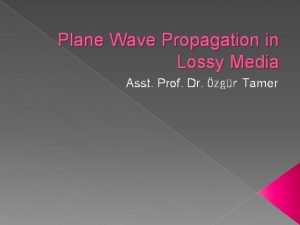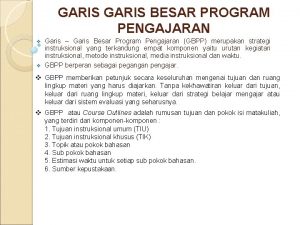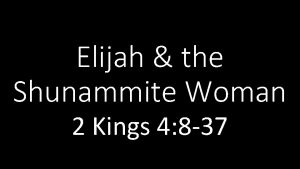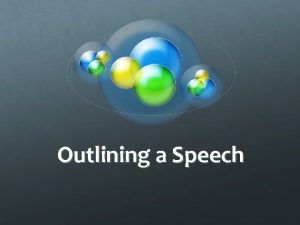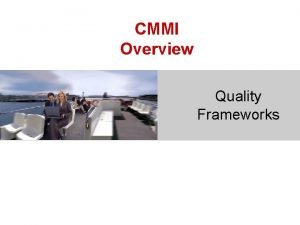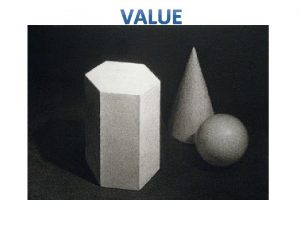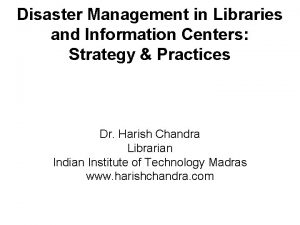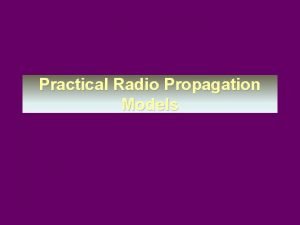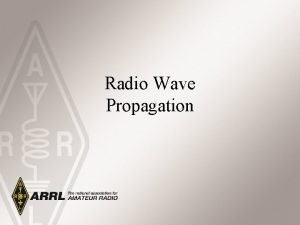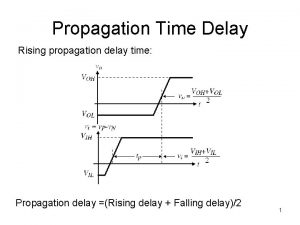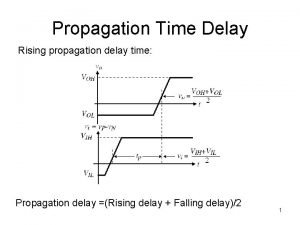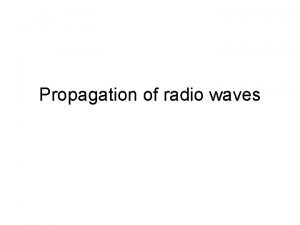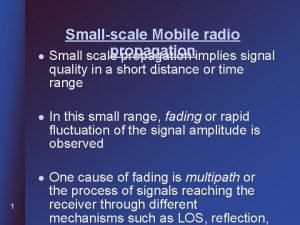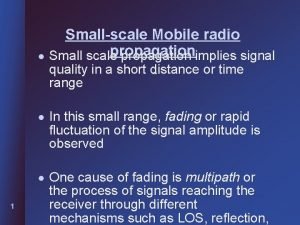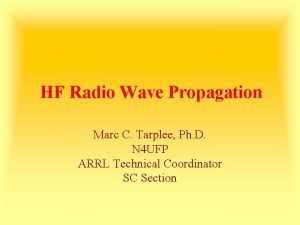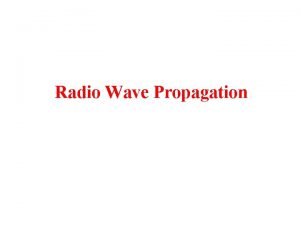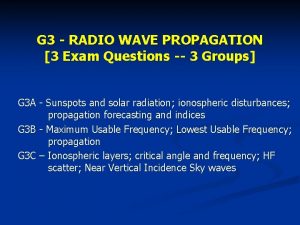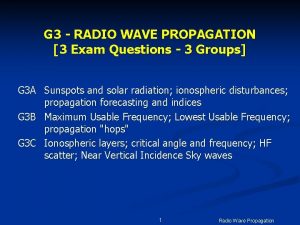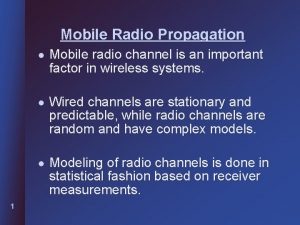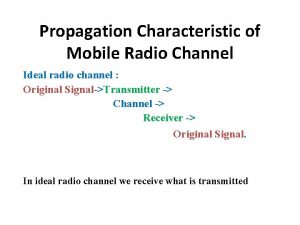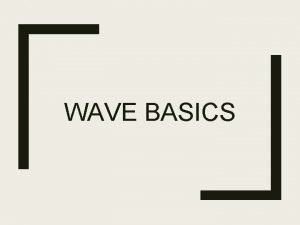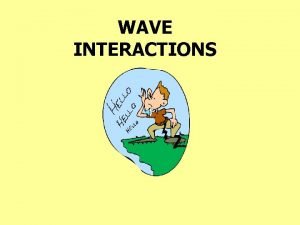Chapter 5 Radio wave Propagation Chapter Outlines The


















































- Slides: 50

Chapter 5 Radio wave Propagation

Chapter Outlines • The Friis Transmission Equation • Propagation Path Loss • Propagation • Ionosphere propagation • Troposphere Propagation • Urban Propagation • Propagation phenomena • Fading and Attenuation • Antenna Noise Temperature • Link Budget Analysis

Introduction Wireless communications involves the transfer of information between two points without direct connection sound, infrared, optical or RF energy. Most modern wireless systems rely on RF or microwave signals, usually in the UHF to millimeter wave freq range. But why high freq? spectrum crowding, need for higher data rates majority of today’s wireless systems operate at freq ranging from 800 MHz to few GHz. E. g. broadcast radio and TV, cellular telephones, DBS TV service, WLAN, GPS and RFID.

Introduction (Cont’d. . ) Characterizing the wireless systems: Ø Point to point radio systems single transmitter with single receiver use high gain antennas in fixed positions to max received power and minimize interference with other radios (nearby frequencies). Ø Point to multipoint systems connect a central station to a large number of possible receivers commercial AM and FM radio and broadcast tv Uses an antenna with broad beam to reach many listeners and viewers.

Introduction (Cont’d. . ) Ø Multipoint to multipoint systems simultaneous communication between individual users (maybe not in fixed location) generally not connect two users directly, but rely on a grid of base stations to provide desired interconnections between users. E. g. cellular telephone systems and WLAN. Can also be characterize in terms of directionality of communication: Ø Simplex system communication occurs in one direction, from tx to rx. E. g. broadcast TV, radio and paging systems.

Introduction (Cont’d. . ) Ø Half Duplex system communication in two directions, but not simultaneously. E. g. early mobile radios (walkie-talkie). . which rely on push to talk function with different intervals of transmitting and receiving. Ø Full Duplex systems simultaneous two-way transmission and reception. E. g. cellular telephone and point to point radio systems require ‘duplexing’ techniques : 1. using separate freq bands for transmit and receive, 2. users to transmit and receive in certain predefined time intervals.

5. 1 The Friis Transmission Equation The Friis transmission equation describes how well the energy is exchanged between transmitter and receiver. Consider a pair of horn antennas with the same polarization and aligned each other.

The Friis Transmission Equation (Cont’d. . ) The radiated power density from Horn 1 at the location of Horn 2 is : The power received by Horn 2 is product of this power density and capture area A 2, written as : The power received at Horn 1 resulting from power emitted by Horn 2 :

The Friis Transmission Equation (Cont’d. . ) The reciprocity property – the transmission pattern is the same as receive pattern, and the ratio of received power to radiated power will be the same, regardless which pair is transmitting or receiving. Therefore, or Since the directivity and area are independent of each other, the ratio must be equal to constant : -

The Friis Transmission Equation (Cont’d. . ) Generally, We find, The ratio is also valid even the antennas are not in line : r – receiver t – transmitter

The Friis Transmission Equation (Cont’d. . ) Replace the effective area with receiving area to get : Finally consider, To get: Simpler Form

The Friis Transmission Equation (Cont’d. . ) The R could be known as distance, d In decibels, Effective isotropic radiated power, EIRP Free space path loss,

The Friis Transmission Equation (Cont’d. . ) This result is known as Friis transmission equation, which addresses on how much power is received by an antenna. Practically, it can be interpreted as the max possible received power, whereby with lot of factors to reduce the received power in actual radio system: • impedance mismatch at either antenna • polarization mismatch between the antennas • propagation effects leads to attenuation or depolarization • multipath effects partial cancellation of the received field.

The Friis Transmission Equation (Cont’d. . ) The received power decreases as 1/R 2 as the separation between transmitter and receiver increases. It seems large for large distance, but it is much better than the exponential decrease in power due to losses in a wired communication link (coax lines, waveguides, even fiber optic lines) the attenuation power on Tline varies as e-2αz , with α is attenuation constant of the line at large distance, the exp function decreases faster than an algebraic dependence like 1/R 2. For long distance communication, radio links perform better than wired links.

Example 1 Consider a pair of half wavelength dipole antennas, separated by 1 km and aligned for maximum power transfer as shown. The transmission antenna is driven with 1 k. W of power at 1 GHz. Assuming antennas are 100% efficient, determine the receiving antenna’s output power. 15

Solution to Example 1 For 100% efficiency and antennas optimally aligned, For the λ/2 dipole antennas we have Dmaxt = Dmaxr = 1. 64 and at 1 GHz, λ = 0. 3 m,

Solution to Example 1 (cont’d. . ) In terms of decibels, So finally,

The Friis Transmission Equation (Cont’d. . ) The Friss transmission equation can also be known as (in terms of receive and transmit) : Whereby, the product of Pt. Gt can be interpreted equivalently as the power radiated by an isotropic antenna with input power Pt. Gt, or effective isotropic radiated power (EIRP):

The Friis Transmission Equation (Cont’d. . ) For a given frequency, range and receiver antenna gain, the received power is proportional to EIRP of transmitter, and can only be increased by increasing the EIRP increase transmit power, or transmit antenna gain or both. In any RF or microwave system, impedance mismatch will reduce the power delivered from a source to a load, where the Friss formula can be multiplied by the impedance mismatch factor,

The Friis Transmission Equation (Cont’d. . ) Max transmission between two antennas requires both antenna be polarized in the same direction. E. g. if a transmit antenna is vertically polarized, max power will be delivered to a vertically polarized receive antenna, while zero power would be delivered to a horizontally polarized received antenna. The polarization mismatch effects is measured by multiplying the Friss formula by the polarization loss factor,

5. 2 Introduction to Propagation

Introduction to Propagation (Cont’d) For frequencies below, about 100 MHz, other propagation effects can be important: • ground surface waves • atmosphere ducting • ionosphere reflection Generally, propagation effects have the effect of reducing the received signal power, thus limit the usable range or maximum data rate of a wireless system.

Propagation path loss • Propagation path loss due to movement of the mobile away from RBS (Radio Base Station) • Propagation over land or sea follows law (propagation power law where �has a theoretical value 4 (for flat earth)) Free Space Power Received Plane Earth Distance

Types of Propagation • Ionosphere Propagation – Using ionospheric propagation, signals leave the transmitting antenna and travel away from the antenna – Signal reflected – Affected by day and night – Also known as sky wave propagation

Types of Propagation • Tropospheric propagation – Radio waves can propagate over the horizon when the lower atmosphere of the earth bends, scatters, and/or reflects the electromagnetic fields. – In the lower part of the earth's atmosphere electromagnetic energy may be reflected/refracted within and between air masses of different density. – – Such propagation is usually of short duration and not suitable for reliable signal transmission.

Urban propagation • Urban environment – Propagation of electromagnetic waves in urban areas in the frequency range above 300 MHz is influenced mainly by the buildings. – Phenomena like multi-path propagation, reflection, diffraction and shadowing have a significant influence on the received power. – Need to consider other path loss model apart from FSPL such as, • Hata-Okumura Model • COST 231 Walfisch Ikegami Model

Urban Propagation Scenario A point to point radio link with a single line of sight propagation path A cellular telephone channel having multiple propagation paths.

5. 3 Propagation Phenomena Attenuation decrease in signal power due to losses in the propagation path. Material Frequency Loss, d. B Concrete Block Wall 1300 MHz 13 Sheetrock 2 x 3/8” 9. 6 GHz 2 Plywood 2 x 3/4” 9. 6 GHz 4 Concrete Wall 1300 MHz 8 -15 Chain Link Fence 1300 MHz 5 -12 Loss Between Floors 1300 MHz 20 -30 Corner in Corridor 1300 MHz 10 -15

Propagation Phenomena Rain Attenuation

Antenna Noise Temperature v. NOISE Noise is any unwanted received signal independent of the transmitted signal and man action v. EXTERNAL NOISE Cosmic noise, Atmospheric noise v. INTERNAL NOISE Cable noise (waveguide or copper), receiver noise (thermal noise)

Antenna Noise Temperature (Cont’d. . ) Natural and manmade sources of background noise.

Antenna Noise Temperature (Cont’d. . ) Antenna noise temperature is the sum of all noise source at the antenna Noise power given by: Where k = Boltzman’s constant = J/K = 228. 6 d. BW/k/Hz T = physical temperature of source in kelvin degree B = noise bandwidth in which the noise power is measured in Hz

Antenna Noise Temperature (Cont’d. . ) Normally, we have the simple case to measure an available output noise power N 0, given by: Illustrating the concept of background temperature. (a) A resistor at temperature T. (b) An antenna in an anechoic chamber at temperature T. (c) An antenna viewing a uniform sky background at temperature T.

Chamber room…

Antenna Noise Temperature (Cont’d. . ) But when the antenna beamwidth is broad enough that different parts of the antenna pattern see different background temperatures, the temperature now is called as effective noise temperature, Te seen by the antenna. This antenna brightness temperature takes into account the distribution of background temperature, directivity and the power pattern function of the antenna

Antenna Noise Temperature (Cont’d. . ) System noise temperature, Ts = Tin + Te where Ts = system temperature Tin = noise temperature of antenna and cable Te = Thermal noise (at Rx) Loss of waveguide between antenna and receiver

Antenna Noise Temperature (Cont’d. . ) So, the system noise temperature Noise power given by:

Antenna Noise Temperature (Cont’d. . ) If given noise in term of noise figure, to find noise temperature and Where F = noise figure (nf) T 0 = ambient temperature

Antenna Noise Temperature (Cont’d. . ) The G/T ratio is another important parameter where the signal to noise ratio (SNR) at the input of a receiver is proportional to G/Ts. The SNR at the input to the receiver can be calculated as:

Antenna Noise Temperature (Cont’d. . ) Where SNR is proportional to G/T of the receive antenna. Only Gr/Ts is controllable at the receiver, and others are fixed by the transmitter design and location. G/T can be maximized by increase the gain of antenna usually minimize reception of noise from hot sources at low elevation angles but higher gain requires larger and more expensive antenna, and high gain may not be desirable for application of omnidirectional coverage!!

Antenna Noise Temperature (Cont’d. . ) • Signal to Noise Ratio or

Example 2 Suppose we have satellite system operates at 12. 5 GHz, with transmit carrier power 120 W, transmit antenna gain 34 d. B, IF Bandwidth 20 MHz. The receiving dish have gain of 33. 5 d. B, with receiver noise figure 1. 1 d. B, locates 39000 km from the satellite. The temperature noise between Tx-Rx are, Tsky = 50 K and TG = 50 K and Lw/g = 1 d. B. Find: (a) EIRP of the transmitter (b) G/T for the receive antenna (c) Received carrier power at receiver terminal (d) Signal to Noise Ratio (SNR)

Solution to Example 2 Convert the quantities in d. B to numerical values: 34 d. B = 2512, 1. 1 d. B = 1. 29, 33. 5 d. B = 2239 The operating frequency 12. 5 GHz, so wavelength 0. 024 m. So, In d. B, convert Pt in d. B, PT = 50. 8 d. Bm

Solution to Example 2 (Cont’d. . ) To find G/T, first find noise temperature of the antenna For Lw/g =1. 29; So then G/T for the antenna is:

Solution to Example 2 (Cont’d. . ) The received carrier power is from Friis formula: Or in d. B

Solution to Example 2 (Cont’d. . ) The SNR at the receiver is: Or in d. B

5. 4 Link Budget

Link Budget If the estimated received power is sufficiently large (typically relative to the receiver sensitivity), the link budget is said to be sufficient for sending data under perfect conditions. Received Power (d. Bm) = Transmitted Power (d. Bm) + Gains (d. B) − Losses (d. B) The amount by which the received power exceeds receiver sensitivity is called the link margin. Link margin = Received Power – Receiver sensitivity SNR = Received power – channel noise Maximum channel noise = Received power – minimum SNR

Example 3 If received power is -30 d. Bm and the system required to achieve a minimum data rate of 54 Mbps. Determine the maximum channel ratio.

Propagation End
 Attenuation constant formula
Attenuation constant formula Awin support
Awin support What is an outlin
What is an outlin Lesson outline for teaching
Lesson outline for teaching Kairos program manual
Kairos program manual Commercial law outlines
Commercial law outlines Four main components for effective outlines
Four main components for effective outlines A business plan is a document that outlines
A business plan is a document that outlines Pathology outline
Pathology outline 2 kings 4 8 17
2 kings 4 8 17 Anima outline
Anima outline Two types of outlines
Two types of outlines A haunted house virginia woolf characters
A haunted house virginia woolf characters Ksf outlines
Ksf outlines Mucoepidermoid carcinoma pathology outlines
Mucoepidermoid carcinoma pathology outlines Cmmi model outlines
Cmmi model outlines Outline of the book of acts
Outline of the book of acts Exegetical sermon outlines
Exegetical sermon outlines Level 3 cjis security test
Level 3 cjis security test Model un position paper outlines
Model un position paper outlines Define visible
Define visible Acute suppurative appendicitis
Acute suppurative appendicitis A clear concise document which outlines preventive
A clear concise document which outlines preventive Electromagnetic radiation scale
Electromagnetic radiation scale Longitudinal vs transverse wave
Longitudinal vs transverse wave Carbon dioxide temperature
Carbon dioxide temperature Difference between full wave and half wave rectifier
Difference between full wave and half wave rectifier Transverse and longitudinal waves both *
Transverse and longitudinal waves both * Half wave rectifier meaning
Half wave rectifier meaning Full wave rectification
Full wave rectification P and s wave chart
P and s wave chart Rectified sine wave fourier series
Rectified sine wave fourier series Longitudinal wave
Longitudinal wave The nature of waves chapter 10 section 1
The nature of waves chapter 10 section 1 Quarter wave symmetry
Quarter wave symmetry Mechanical and electromagnetic waves venn diagram
Mechanical and electromagnetic waves venn diagram Example of mechanical waves
Example of mechanical waves Wavelength formula triangle
Wavelength formula triangle Hình ảnh bộ gõ cơ thể búng tay
Hình ảnh bộ gõ cơ thể búng tay Frameset trong html5
Frameset trong html5 Bổ thể
Bổ thể Tỉ lệ cơ thể trẻ em
Tỉ lệ cơ thể trẻ em Chó sói
Chó sói Tư thế worms-breton
Tư thế worms-breton Bài hát chúa yêu trần thế alleluia
Bài hát chúa yêu trần thế alleluia Môn thể thao bắt đầu bằng chữ f
Môn thể thao bắt đầu bằng chữ f Thế nào là hệ số cao nhất
Thế nào là hệ số cao nhất Các châu lục và đại dương trên thế giới
Các châu lục và đại dương trên thế giới Công thức tiính động năng
Công thức tiính động năng Trời xanh đây là của chúng ta thể thơ
Trời xanh đây là của chúng ta thể thơ Mật thư anh em như thể tay chân
Mật thư anh em như thể tay chân
